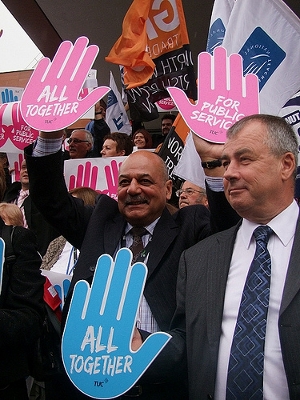 With aggressive cuts currently being imposed on public services in most European countries, trade unions are again under the media spotlight, often criticised for strike actions and bullying behaviour. But what do we really know about British union members? Tim Vlandas offers a detailed insight into union members’ views and preferences, questioning the dominant narrative that unions were mostly reluctant actors of Tony Blair’s Third Way paradigm.
With aggressive cuts currently being imposed on public services in most European countries, trade unions are again under the media spotlight, often criticised for strike actions and bullying behaviour. But what do we really know about British union members? Tim Vlandas offers a detailed insight into union members’ views and preferences, questioning the dominant narrative that unions were mostly reluctant actors of Tony Blair’s Third Way paradigm.
As cuts to public services continue to bite, trade unions are once again in the spotlight of the media. Britain is no exception to this rule; this month’s Trade Union Congress conference called for a massive public sector strike in November over public sector pension plans. Too often, opponents and proponents of trade unions argue over what unions can and should rightfully do under the current circumstances.
But what do we really know about union members? Or indeed what their preferences are? Using survey data from the 2008 European Social Survey, we can see that more women are now in unions, the share of union members in the public sector has increased, and union membership in the private sector has largely declined. Union members also seem more insulated from unemployment risk and temporary work. They are still core supporters of Labour and the left, and tend to support greater equality and the welfare state more than non-union members.
So, how are unions made up, and what can that tell us?
Traditionally, unions were male dominated organizations. This is no longer the case; by 2008 the situation had reversed, with about 53 per cent of union members being women. Union members are almost entirely British – 94 per cent compared to a national average of 89 per cent.

Stereotypes about union members being older, permanent employees would appear to be true – the majority (more than 50 per cent) of union members are between 35 and 54 years old. Only about 20 per cent are under 35. Union members are mostly permanent employees, with only 5 per cent working in a contract of limited duration whereas the average for all respondents is about 9 per cent.
As could be expected, unions are dominated by those working in the public sector. 22 per cent work for central or local government, versus only 6.5 per cent for respondents not in unions. In addition, 34 per cent work for other public sector organisations (such as education and health) whereas only 11 per cent of Survey respondents not in unions work for such sectors. 36 per cent of union members work in private firms, showing that unions are not completely disconnected from the private sector, as many on the right might maintain.
Looking at unemployment and earnings, union members tend to be better off than non-union members. Given the higher than average job tenure in the public sector, it is therefore not surprising that only 15 per cent of union members have experienced a period of unemployment and work seeking in the past 5 years. More than 50 per cent of union members earned more than £25,000 per year (about 38 per cent for non-union members) and 14.9 per cent earned more than £38,060.
Union members are more likely to vote, and vote for Labour
Among union members, 74 per cent voted in the last election while only 58 per cent voted among non-union members. Of union members who voted, a small majority (just above 50 per cent) voted for the Labour party in the last national election (i.e.: in 2005, before the survey was completed). About 20 per cent voted for the Liberals Democrats, and a similar share voted for the Conservatives. By contrast, among those not in unions, 40 per cent voted for the Conservatives, 36 per cent for Labour and only 15 per cent for the Liberal Democrats. These results generally reflect respondents’ location on a left-right scale, with 39 per cent locating themselves to the left and 38 per cent in the centre, with 23 per cent on the right.
Union members are also keen on reducing inequalities; 64 per cent of union members agree or strongly agree with the statement that governments should reduce differences in income levels. However, union members have a different stance on talent reward, with 59 per cent of union members agreeing that large income differences are acceptable to reward talents and efforts. 64 per cent of non-union members feel the same way, so this is not a huge point of difference.
Moving on to social benefits provided by government, 56 per cent of union members and 55 per cent of non-members agree or strongly agree that social benefits and services prevent widespread poverty. However, both see social benefits and services as a problem for the economy. 46 per cent of union members, versus 51 per cent for non-members, agree or strongly agree that social benefits and services place too great a strain on the economy. 28 per cent strongly of union members disagree, against 19 per cent for non-members.
While 40 per cent of union members agree or strongly agree that these benefits and services cost businesses too much in taxes, the share among non-union members is over 50 per cent. Interestingly, 57 per cent of union members agree that social benefits and services make people lazy, while 67 per cent of non-members agree or strongly agree with the statement.
Union members and the third way agenda
67 per cent of union members agree or strongly agree that sentences for those who break the law should be harsher (78 per cent for non-union members), which shows that while there remain important differences between union members and non-members, the third way agenda emphasising greater individual responsibility and a tougher stance on justice was shared by the majority of union members.
Unsurprisingly then, almost 30 per cent of union members seemed in favour of reducing taxes and social spending (compared with about 34 per cent for non-members). Similarly, about the same share of union members and non-members (42 per cent) agreed that high earners and low earners should pay the same share of their income. A staggering 71 per cent of union respondents agreed or strongly agreed that many people manage to get benefits or services that they are not entitled to (about 77 per cent for non-members).
These findings question the dominant narrative that unions were mostly reluctant actors of the turn to the third way paradigm. Many in unions now agree that income differences are appropriate to reward talent, that sentences should be harsher and that benefits have negative disincentive effects on recipients and detrimental consequences for the economy. This shifts our attention towards changes within union structures and preferences and away from the assumption that reluctant, and weakened, unions are having changes imposed on them by the Labour party.
Please read our comments policy before commenting.







